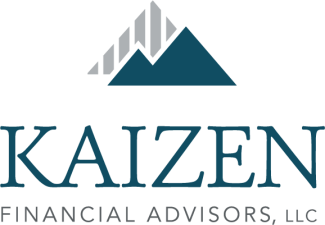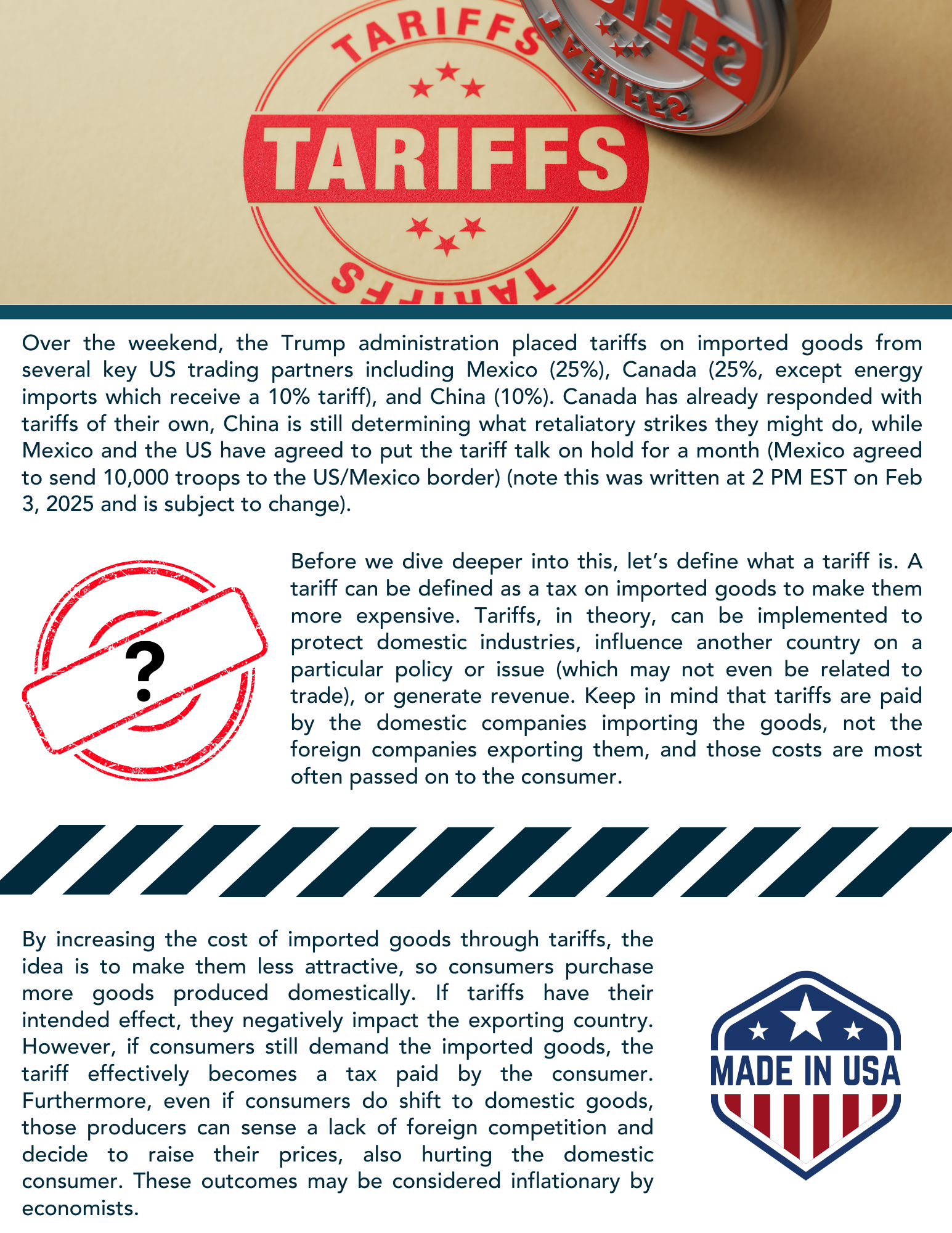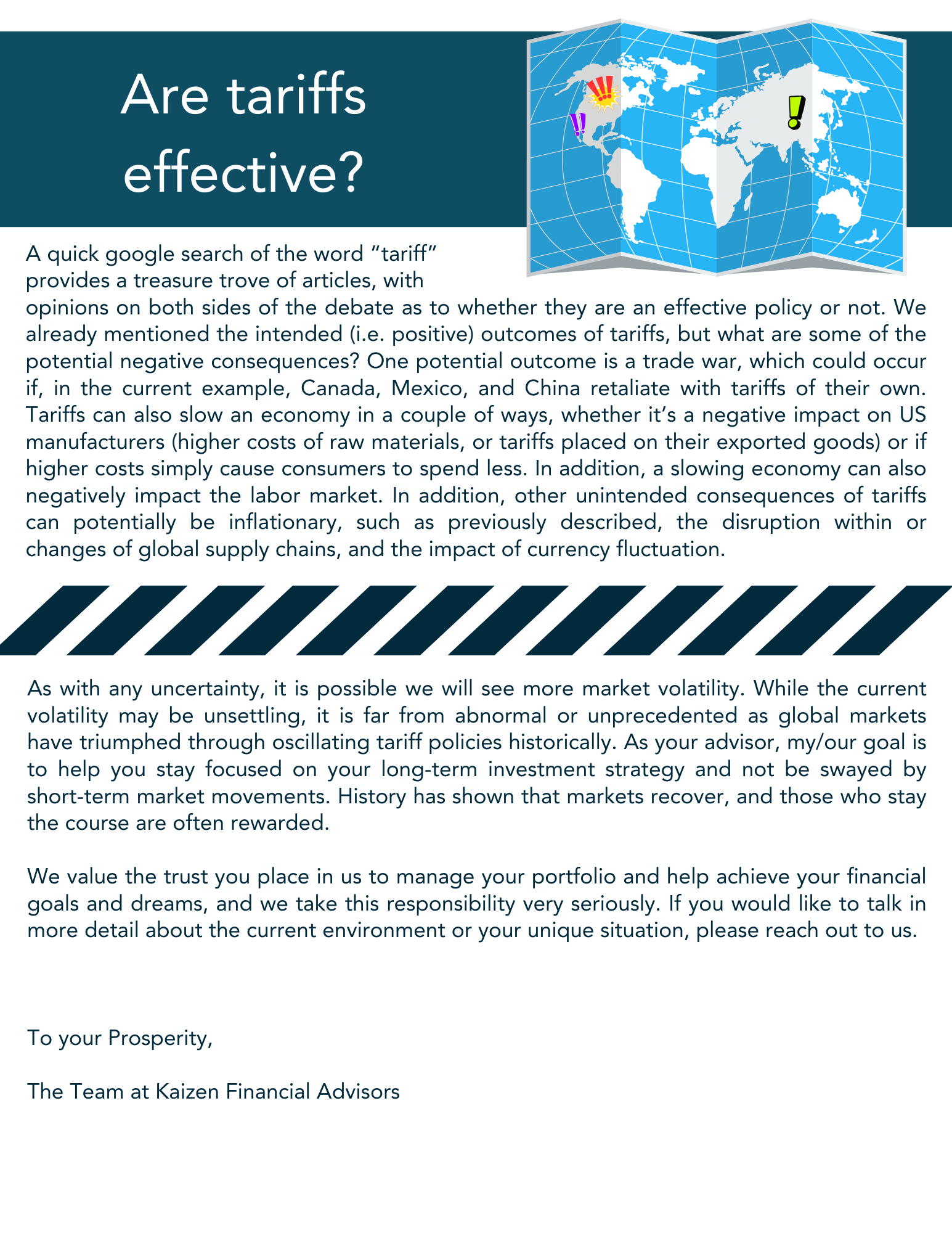
Tariffs: What They Are and Their Possible Impacts
Over the weekend, the Trump administration placed tariffs on imported goods from several key US trading partners including Mexico (25%), Canada (25%, except energy imports which receive a 10% tariff), and China (10%). Canada has already responded with tariffs of their own, China is still determining what retaliatory strikes they might do, while Mexico and the US have agreed to put the tariff talk on hold for a month (Mexico agreed to send 10,000 troops to the US/Mexico border) (note this was written at 2 PM EST on Feb 3, 2025 and is subject to change).
By increasing the cost of imported goods through tariffs, the idea is to make them less attractive, so consumers purchase more goods produced domestically. If tariffs have their intended effect, they negatively impact the exporting country. However, if consumers still demand the imported goods, the tariff effectively becomes a tax paid by the consumer. Furthermore, even if consumers do shift to domestic goods, those producers can sense a lack of foreign competition and decide to raise their prices, also hurting the domestic consumer. These outcomes may be considered inflationary by economists.
A quick google search of the word “tariff” provides a treasure trove of articles, with opinions on both sides of the debate as to whether they are an effective policy or not. We already mentioned the intended (i.e. positive) outcomes of tariffs, but what are some of the potential negative consequences? One potential outcome is a trade war, which could occur if, in the current example, Canada, Mexico, and China retaliate with tariffs of their own. Tariffs can also slow an economy in a couple of ways, whether it’s a negative impact on US manufacturers (higher costs of raw materials, or tariffs placed on their exported goods) or if higher costs simply cause consumers to spend less. In addition, a slowing economy can also negatively impact the labor market. In addition, other unintended consequences of tariffs can potentially be inflationary, such as previously described, the disruption within or changes of global supply chains, and the impact of currency fluctuation.
As with any uncertainty, it is possible we will see more market volatility. While the current volatility may be unsettling, it is far from abnormal or unprecedented as global markets have triumphed through oscillating tariff policies historically. As your advisor, my/our goal is to help you stay focused on your long-term investment strategy and not be swayed by short-term market movements. History has shown that markets recover, and those who stay the course are often rewarded. We value the trust you place in us to manage your portfolio and help achieve your financial goals and dreams, and we take this responsibility very seriously. If you would like to talk in more detail about the current environment or your unique situation, please reach out to us. To your Prosperity, The Team at Kaizen Financial Advisors
Introducing Kaizen Quick Tips Life’s busy, so we’re bringing you bite-sized nuggets of wisdom—everything from smart financial moves to clever organization hacks, plus a sprinkle of fun. Quick, clever, and completely worth your time!
With millions of people receiving unemployment, it’s no surprise that scammers are taking advantage of this situation and filing fraudulent claims for unemployment compensation. They do this by using stolen personal information of taxpayers who haven’t filed unemployment claims. If you filed for unemployment and received an incorrect Form 1099-G, contact the issuing agency to request a revised form. When filing your federal tax return, you can also contact the IRS and request an identity protection PIN to protect your identity. Educate yourself on the many signs of identity theft and take the proper steps to help protect yourself. This information is not a substitute for individualized tax advice. Please discuss your specific tax issues with a qualified tax professional. There’s something satisfying about cleaning out your closet, especially at this time of year. Here are some tips on how to make spring cleaning your closet a little easier. Not sure what to keep or get rid of? Try the clothes hanger hack! Turn all your coat hangers around so they face away from you, and over the course of a month or two, turn the hangers around as you wear your clothes. Then, you can see what you wear and clean your closet accordingly. Sort your clothing by color - make your closet a rainbow of cheer! Make your closet feel more spacious by hanging pants and skirts on the top rack and shirts, blouses, and blazers on the bottom rack. Separate your clothes by season and neatly pack away the clothes you aren’t wearing for future use. To save space, use a vacuum sealer. Label your storage containers or bags to remember what’s in each. Save space by shopping for wardrobe accessories like shoe organizers, slimmer hangers, or necklace/scarf organizers.





